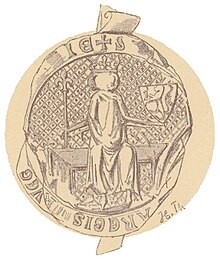| Haakon VI | |
|---|---|
 The royal seal of Haakon VI | |
| King of Norway | |
| Reign | 15 August 1343 – 11 September 1380 |
| Predecessor | Magnus Eriksson |
| Successor | Olaf IV |
| Co-ruler | Magnus Eriksson (1343-1364) |
| King of Sweden | |
| Reign | 1362–1364 |
| Predecessor | Magnus Eriksson |
| Successor | Albert |
| Co-ruler | Magnus Eriksson |
| Born | possibly August 1340 Likely Sweden |
| Died | September 11, 1380 (aged 40) Oslo, Norway |
| Burial | |
| Spouse | |
| Issue | Olaf II of Denmark |
| House | House of Bjälbo |
| Father | Magnus Eriksson |
| Mother | Blanche of Namur |
Haakon VI (Norwegian: Håkon, Swedish: Håkan; c. August 1340 – 11 September 1380), also known as Håkan Magnusson, was King of Norway from 1343 until his death and King of Sweden between 1362 and 1364. He is sometimes known as Haakon Magnusson the Younger to distinguish him from his great-grandfather, Haakon V (reigned 1299–1319).[1]
Haakon was the younger son of Magnus Eriksson, king of both Norway and Sweden. His older brother Eric was meant to succeed their father on the throne of Sweden, while Haakon was made king of Norway in his father's lifetime. Magnus greatly favored Haakon over Eric, leading to the latter's rebellion and seizure of Southern Sweden. Eric died in 1359, and Haakon became co-ruler of Sweden with his father three years later. The two reigned over Sweden together until 1364, when they were deposed in favor of Magnus' sororal nephew, Albert of Mecklenburg, by a clique of exiled Swedish noblemen led by Bo Jonsson Grip. Magnus and Haakon tried to retake the Swedish throne, but without success.[2]
In 1363, Haakon married Margaret, daughter of Valdemar IV of Denmark. The marriage, itself a significant element in the Nordic power struggle, resulted in the birth of one son, Olav. Haakon's continuous conflicts with his father-in-law ended only with the latter's death in 1375. Haakon seized the opportunity to have his son elected Valdemar's successor, defeating the claims of his and his wife's Mecklenburg relatives.
Upon his death in 1380, Haakon was succeeded by Olav, with Margaret as regent. Olav died childless seven years later, and Haakon's widow proceeded to assert authority over all three Scandinavian kingdoms as their first female monarch.
- ^ Cite error: The named reference
Britannicawas invoked but never defined (see the help page). - ^ "Håkon 6 Magnusson". 27 September 2021.